大三环境工程专业英语期末复习
- 格式:docx
- 大小:15.30 KB
- 文档页数:1
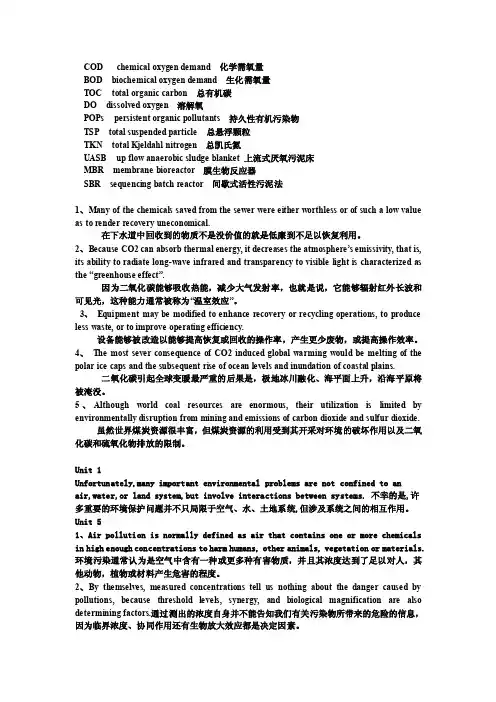
COD chemical oxygen demand化学需氧量BOD biochemical oxygen demand 生化需氧量TOC total organic carbon 总有机碳DO dissolved oxygen 溶解氧POPs persistent organic pollutants 持久性有机污染物TSP total suspended particle 总悬浮颗粒TKN total Kjeldahl nitrogen 总凯氏氮UASB up flow anaerobic sludge blanket 上流式厌氧污泥床MBR membrane bioreactor 膜生物反应器SBR sequencing batch reactor 间歇式活性污泥法1、Many of the chemicals saved from the sewer were either worthless or of such a low value as to render recovery uneconomical.在下水道中回收到的物质不是没价值的就是低廉到不足以恢复利用。
2、Because CO2 can absorb thermal energy, it decreases the atmosphere’s emissivity, that is, its ability to radiate long-wave infrared and transparency to visible light is characterized as the “greenhouse effect”.因为二氧化碳能够吸收热能,减少大气发射率,也就是说,它能够辐射红外长波和可见光,这种能力通常被称为“温室效应”。
3、Equipment may be modified to enhance recovery or recycling operations, to produce less waste, or to improve operating efficiency.设备能够被改造以能够提高恢复或回收的操作率,产生更少废物,或提高操作效率。

汉译英&英译汉(Note Book)Unit1life expectancy(预期寿命) poverty-stricken(极其贫困,贫困不堪的) smog-laden air(充满烟雾的空气) 补:panic-stricken(极其恐慌的)global conditions(全球状况) haves and have-nots(富人和穷人) underprivileged(贫困的,社会地位低下的)savanna(热带草原,热带的稀树大草原)predator(捕食者,食肉动物)environmental disruptions(环境破坏)Unit5primary pollutant 一次污染物secondary pollutant 二次污染物air stagnation 空气停滞nitrous oxide 氧化亚氮nitric oxide 一氧化氮nitrogen dioxide 二氧化氮soot 烟尘dust 粉尘smog 烟雾ozone 臭氧herbicide 除草剂pesticide 除虫剂Unit10treatment facilities: 处理设备,净化结构municipality: 市政当局,自治市population equivalent: 人口当量basement flooding: 地下室浸水per capital per day: 每人每天runoff: 排水,径流,溢出domestic sewage: 生活污水the type of terrain: 地形种类Unit12land disposal 掩埋处置fecal coliform 类大肠菌群stringent effluent requirement 严格的废水排放要求assimilation capacity 同化能力practical outlets 现实出路aquatic life 水生物detrimental to human health 对人体健康有害的endogenous phase 内源生长期Unit13flow monitoring 流量监测equipment age and reliability 装备老化mechanistic facilities 机械设备microbial activity 微生物活性activated sludge 活性污泥controlling respiration 控制呼吸oxidation ditches 氧化沟on-line automation 在线监测Unit14biological degradation 生物降解equalization basin(pond)均质池(塘)aeration basin(tank)曝气池(槽)sludge flocs 污泥絮凝体settling tank 沉降槽dissolved oxygen 溶解氧biofilm 生物膜suspended-growth 悬浮生长Unit21well-compacted landfill 夯实良好的填埋场pulverized refuse 磨(研)碎的垃圾fluidized bed incineration 流化床焚烧wet oxidation 湿式氧化anaerobic digestion 厌氧硝化/过程nutrient source 营养源soil conditioners 土壤改良剂mass-burning 大量燃烧municipal waste 城市垃圾Unit26action 行为biogeophysical environment 地球环境surperficial analyses 肤浅(表面)分析an identification of human concerns 个人的担忧remedial action 补救行动,纠正措施relevant physical and biological factors 有关物质因素和生物因素 a spatial 无空间的frame of reference 参照系(标准)Unit 1农药(pesticide)化肥(chemical fertilizer)有机废物(organic wastes)微生物(organism)衰减(reduction)阻滞的(retardant)稀释(dilute)添加剂(additives)合成塑料(synthetic plastic)再生(regeneration/recovery)Unit 5正常浓度normal concentration 严重污染的heavily polluted决定因素determing factors 光化学氧化物photochemical oxide液体微滴liquid droplet 放射性物质radioactive substance不完全氧化incomplete oxidation 含硫的sulfuric(sulfur content)风化weathering 汽车尾气automobile exhaustUnit 7出口outlet 多管高效旋风分离器multitube high-efficiency cyclone 合成纤维synthetic fibre 捕集效率collection efficiency机械洗涤mechanical scrubbing(washing)压力降pressure drop焚化炉inciner furnace 气体离子gas ions捕集板collection board 炭黑carbon-blackUnit 9肺囊lung pocket (lung-sac)氟中毒fluorosis 煤烟soot呼吸系统respiratory system 过滤filter 吸附adsorb浓度concentration 硫化氢hydrogen sulfide 硫化铅lead sulfide Unit 13手动控制operator control/ manual control 最优化the most optimization 微处理器microprocessor 统计分析statistical analysis质量衡算mass balance 动力学dynamics氧化还原oxidation and reduction /redox 停留时间residence time模拟simulation 参数parameter水解hydrolysis 积分integralUnit 25温度每升高10℃every rise in temperature of 10℃内部调节机制internal regulatory mechanisms一百万千瓦one-million-kilowatt 热血动物warm-blooded animals 神经系统nervous system 食物链food chain非哺乳动物non-mammalian 冷却系统cooling system热力学第二定律the Second Law of ThermodynamicsUnit 26地理环境geographic environment影响评价方法methodologies for impact assessment替代方案的研究study of alternatives有关环境质量的各组分相对值the relative worth of various components of environmental quality 环境质量标准criteria for environmental quality模型技术modeling techniques基础数据the data baseUnit71.The spiral motion produces the centrifugal forces that cause the particulate matter to move toward the periphery of the vessel and collect on the walls and fall to the bottom of the vessel.旋转运动产生的离心力使颗粒物移向锥体的外围然后沿外壁落入容器的底部(灰斗)。
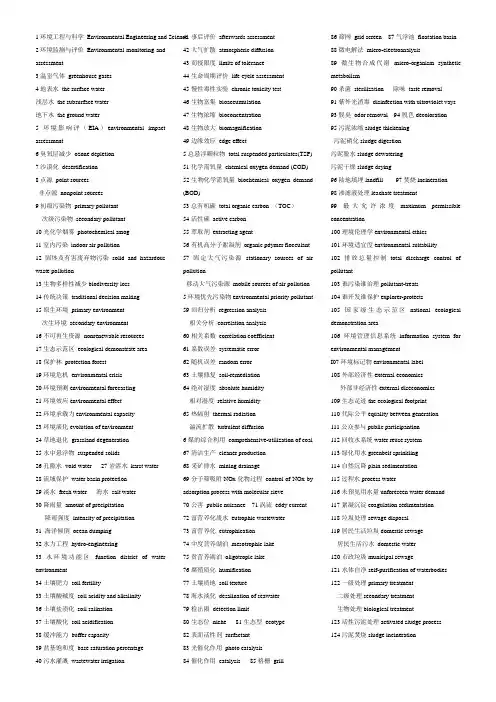
1环境工程与科学 Environmental Engineering and Science 2环境监测与评价 Environmental monitoring and assessment3温室气体 greenhouse gases 4地表水 the surface water 浅层水 the subsurface water 地下水 the ground water5环境影响评(EIA )environmental impact assessment6臭氧层减少 ozone depletion 7沙漠化 desertification 8点源 point sources 非点源 nonpoint sources 9初级污染物 primary pollutant 次级污染物 secondary pollutant 10光化学烟雾 photochemical smog 11室内污染 indoor air pollution12固体及有害废弃物污染 solid and hazardous waste pollution13生物多样性减少biodiversity loss 14传统决策 traditional decision making 15原生环境 primary environment 次生环境 secondary environment 16不可再生资源 nonrenewable resources 17生态示范区 ecological demonstrate area 18保护林 protection forest 19环境危机 environmental crisis 20环境预测environmental forecasting 21环境效应environmental effect 22环境承载力environmental capacity 23环境演化evolution of environment 24草地退化 grassland degeneration 25水中悬浮物 suspended solids26孔隙水 void water 27岩溶水 karst water 28流域保护 water basin protection 29淡水 fresh water 海水 salt water 30降雨量 amount of precipitation 降雨强度 intensity of precipitation 31 海洋倾倒 ocean dumping 32水力工程 hydro-engineering33水环境功能区 function district of water environment34土壤肥力 soil fertility33土壤酸碱度 soil acidity and alkalinity 36土壤盐渍化 soil salination 37土壤酸化 soil acidification 38缓冲能力 buffer capacity39盐基饱和度 base saturation percentage 40污水灌溉 wastewater irrigation41事后评价 afterwards assessment 42大气扩散 atmospheric diffusion 43而授限度 limits of tolerance 44生命周期评价 life cycle assessment 45慢性毒性实验 chronic toxicity test 46生物富集 bioaccumulation 47生物浓缩 bioconcentration 48生物放大 biomagnification 49边缘效应 edge effect5总悬浮颗粒物 total suspended particulates(TSP) 51化学需氧量 chemical oxygen demand (COD) 52生物化学需氧量 biochemical oxygen demand (BOD)53总有机碳 total organic carbon (TOC ) 54活性碳 active carbon 55萃取剂 extracting agent56有机高分子絮凝剂 organic pdymer flocculant 57固定大气污染源 stationary sources of air pollution移动大气污染源 mobile sources of air pollution 5环境优先污染物environmental priority pollutant 59回归分析 regression analysis 相关分析 correlation analysis 60相关系数 correlation coefficient 61系数误差 systematic error 62随机误差 random error 63土壤修复 soil-remediation 64绝对湿度 absolute humidity 相对湿度 relative humidity 65热辐射 thermal radiation 湍流扩散 turbulent diffusion6煤的综合利用 comprehensive-utilization of coal 67清洁生产 cleaner production 68采矿排水 mining drainage69分子筛吸附NOx 化物过程 control of NOx by adsorption process with molecular sieve70公害 public nuisance 71涡流 eddy current 72富营养化废水 eutrophic wastewater 73富营养化 eutrophication 74中度营养湖泊 mesotrophic lake 75贫营养湖泊 oligotropic lake 76腐殖质化 humification 77土壤质地 soil texture78海水淡化 desalination of seawater 79检出限 detection limit80生态位 niche 81生态型 ecotype 82表面活性剂 surfactant 83光催化作用 photo catalysis84催化作用 catalysis 85格栅 grill86筛网 grid screen 87气浮池 floatation basin 88微电解法 micro-electroanalysis89微生物合成代谢 micro-organism synthetic metabolism90杀菌 sterilization 除味 taste removal 91紫外光消毒 disinfection with ultroviolet vays 93脱臭 odor removal 94脱色decoloration 95污泥浓缩sludge thickening 污泥硝化sludge digestion 污泥脱水sludge dewatering 污泥干燥sludge drying96陆地填埋landfill 97焚烧incineration 98渗滤液处理leachate treatment99最大允许浓度maximum permissible concentration100理境伦理学environmental ethics 101环境适宜度environmental suitability 102排放总量控制total discharge control of pollutant103谁污染谁治理pollutant-treats 104谁开发谁保护explorer-protects105国家级生态示范区national ecological demonstration area106环境管理信息系统information system for environmental management I07环境标记物environmental label 108外部经济性external economics 外部非经济性external diseconomics 109生态足迹the ecological footprint 110代际公平equality between generation 111公众参与public participantion 112回收水系统water reuse system 113绿化用水greenbelt sprinkling 114自然沉降plain sedimentation 115过程水process water116未预见用水量unforeseen water demand 117絮凝沉淀coagulation sedimentation 118垃圾处理sewage disposal 119居民生活垃圾domestic sewage 居民生活污水 domestic water 120市政垃圾municipal sewage121水体自净self-purification of waterbodies 122一级处理primary treatment 二级处理secondary treatment 生物处理biological treatment123活性污泥处理activated sludge process 124污泥焚烧sludge incinerationThe answer to this question requires detailed analyse of local conditions and needs,application of scientific knowledge and engineering judgement based on past experience,and consideration of federal,state,and local regulations. 要解答这个问题首先需要详细的分析当地的实际情况和需求,其次需要应用科学知识和基于经验的工程决断,最后考虑联邦,州和当地法规。
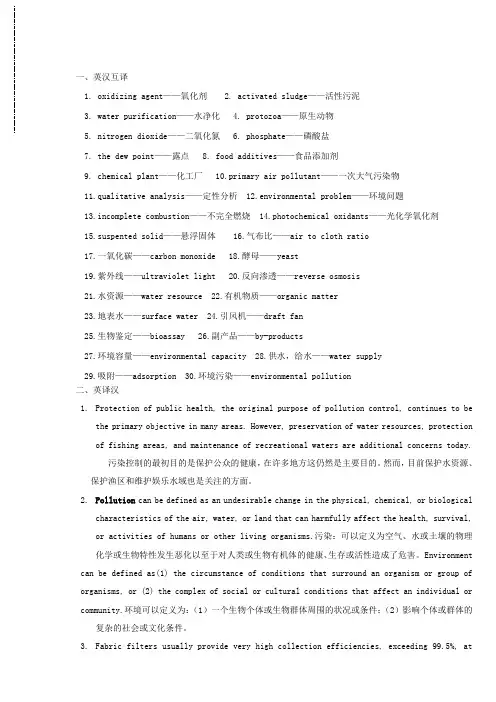
一、英汉互译1. oxidizing agent——氧化剂2. activated sludge——活性污泥3. water purification——水净化4. protozoa——原生动物5. nitrogen dioxide——二氧化氮6. phosphate——磷酸盐7. the dew point——露点 8. food additives——食品添加剂9. chemical plant——化工厂 10.primary air pollutant——一次大气污染物11.qualitative analysis——定性分析 12.environmental problem——环境问题13.incomplete combustion——不完全燃烧 14.photochemical oxidants——光化学氧化剂15.suspented solid——悬浮固体 16.气布比——air to cloth ratio17.一氧化碳——carbon monoxide 18.酵母——yeast19.紫外线——ultraviolet light 20.反向渗透——reverse osmosis21.水资源——water resource 22.有机物质——organic matter23.地表水——surface water 24.引风机——draft fan25.生物鉴定——bioassay 26.副产品——by-products27.环境容量——environmental capacity 28.供水,给水——water supply29.吸附——adsorption 30.环境污染——environmental pollution二、英译汉1.Protection of public health, the original purpose of pollution control, continues to bethe primary objective in many areas. However, preservation of water resources, protection of fishing areas, and maintenance of recreational waters are additional concerns today.污染控制的最初目的是保护公众的健康,在许多地方这仍然是主要目的。
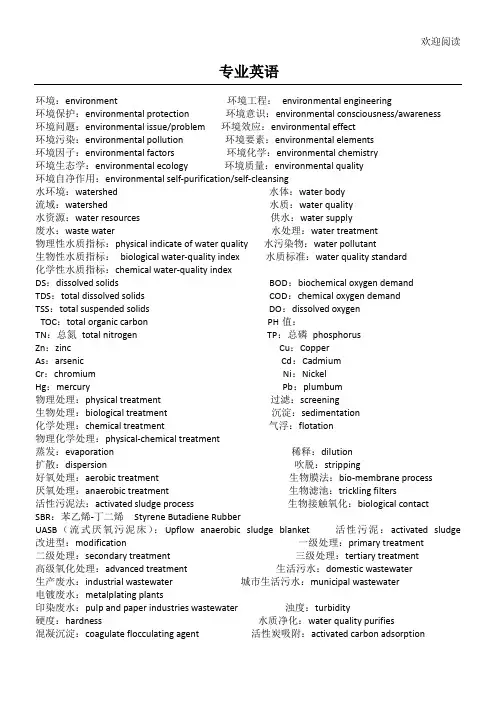
欢迎阅读专业英语环境:environment 环境工程:environmental engineering环境保护:environmental protection 环境意识:environmental consciousness/awareness环境问题:environmental issue/problem 环境效应:environmental effect环境污染:environmental pollution 环境要素:environmental elements环境因子:environmental factors 环境化学:environmental chemistry环境生态学:environmental ecology 环境质量:environmental quality环境自净作用:environmental self-purification/self-cleansing水环境:watershed 水体:water body流域:watershed 水质:water quality水资源:water resources 供水:water supply废水:waste water 水处理:water treatment物理性水质指标:physical indicate of water quality 水污染物:water pollutant生物性水质指标:biological water-quality index 水质标准:water quality standard化学性水质指标:chemical water-quality indexDS:dissolved solids BOD:biochemical oxygen demandTDS:total dissolved solids COD:chemical oxygen demandTSS:total suspended solids DO:dissolved oxygenTOC:total organic carbon PH值:TN:总氮total nitrogen TP:总磷phosphorusZn:zinc Cu:CopperAs:arsenic Cd:CadmiumCr:chromium Ni:NickelHg:mercury Pb:plumbum物理处理:physical treatment 过滤:screening生物处理:biological treatment 沉淀:sedimentation化学处理:chemical treatment 气浮:flotation物理化学处理:physical-chemical treatment蒸发:evaporation 稀释:dilution扩散:dispersion 吹脱:stripping好氧处理:aerobic treatment 生物膜法:bio-membrane process厌氧处理:anaerobic treatment 生物滤池:trickling filters活性污泥法:activated sludge process 生物接触氧化:biological contactSBR:苯乙烯-丁二烯Styrene Butadiene RubberUASB(流式厌氧污泥床):Upflow anaerobic sludge blanket 活性污泥:activated sludge 改进型:modification 一级处理:primary treatment二级处理:secondary treatment 三级处理:tertiary treatment高级氧化处理:advanced treatment 生活污水:domestic wastewater生产废水:industrial wastewater 城市生活污水:municipal wastewater电镀废水:metalplating plants印染废水:pulp and paper industries wastewater 浊度:turbidity硬度:hardness 水质净化:water quality purifies混凝沉淀:coagulate flocculating agent 活性炭吸附:activated carbon adsorption欢迎阅读隔油池:oil separation tank 中和池:neutralization tank调节池:adjusting tank 生物反应池:biological reactor加药设备:physical equipment 沉淀池:sedimentation tank初沉池:primary sedimentation tank 二沉池:secondary sedimentation tank絮凝剂:flocculant 混凝剂:coagulate flocculant生物降解:biodegradation 生物累积:bioaccumulation飘尘:floating dust 可吸入颗粒物:inhalable particles能见度:visibility 酸雨:acid rain一次污染物:primary pollutant二次污染物:secondary pollutant 氮氧化物:nitrogen oxides硫氧化物:sulfur oxides硫化氢:hydrogen sulfide 碳氧化物:carbon oxides硝酸:nitric acid 盐酸:hydrochloric acid硫酸:sulfuric acid 二氧化硫:sulfur dioxide除尘工艺:Dust removal吸收:absorption 吸附:adsorption静电除尘:electric dust precipitation 重力除尘:gravitational settling臭氧:ozone光化学烟雾:photochemical smoke 喷淋(洗涤):scavenging土壤:soil 热污染:temperature change/thermal pollution 噪声:noise 放射性:radioactivityEIA:environmental impact assessment CAD(计算机辅助设计):computer aided design大气污染控制工程:air pollution control 水污染控制工程:water pollution control固体废物污染控制工程:solid waste management污染源:pollution source同化作用:assimilation 固体废物:solid wastes危险废物:hazardous wastes化学污泥chemical sludge:生物污泥:biological sludge工业固废:industrialwastes 分选处理:separation treatment矿业固废:mine solid wastes 破碎处理:processing农业固废:agriculture solid wastes 压实处理:reduction in volume污泥脱水:disposal of the sludge ?污泥浓缩:sludge thickening带式压滤:Belt filter press离心脱水:centrifugal dewatering筛分:screening堆肥和堆肥化:compost and composting 沼气和沼气化:biogas热解与焚烧:pyrolysis and incineration 生物转化作用:biotransformation热化学转化作用:thermo-chemical固化和稳定化作用:solidification and stabilization资源化:resource减量化:pollution control无害化:harmlessness固体废物全过程控制:solid waste integrated control固体废物污染控制:solid waster pollution control固体废物处理:processing and recovery 处置:disposal物质回收:materials recovery 物质转化:material conversion能量回收:energy recovery 能量转化:energy conversion1.Environmental engineering has been defined as the branch of engineering that isconcerned with protecting the environment from the potential, deleterious effects of human activity, protecting human populations from the effects of adverse environmental factors, and improving environmental quality for human health and well-being.(2页)环境工程学是环境工程的分支学科,其研究内容包括①保护环境免受人类活动改造形成的潜在和不利影响②保护人类免受不利环境因素的影响③持续改善环境质量,以造福于人类健康与福祉。
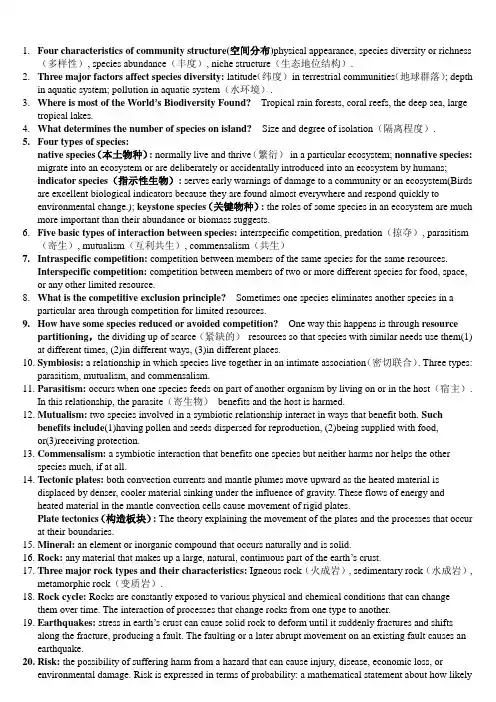
1.Four characteristics of community structure(空间分布)physical appearance, species diversity or richness(多样性), species abundance(丰度), niche structure(生态地位结构).2.Three major factors affect species diversity: latitude(纬度)in terrestrial communities(地球群落); depthin aquatic system; pollution in aquatic system(水环境).3.Where is most of the W orld’s Biodiversity Found?Tropical rain forests, coral reefs, the deep sea, largetropical lakes.4.What determines the number of species on island?Size and degree of isolation(隔离程度).5.Four types of species:native species(本土物种): normally live and thrive(繁衍)in a particular ecosystem; nonnative species: migrate into an ecosystem or are deliberately or accidentally introduced into an ecosystem by humans;indicator species(指示性生物): serves early warnings of damage to a community or an ecosystem(Birds are excellent biological indicators because they are found almost everywhere and respond quickly toenvironmental change.); keystone species(关键物种): the roles of some species in an ecosystem are much more important than their abundance or biomass suggests.6.Five basic types of interaction between species: interspecific competition, predation(掠夺), parasitism(寄生), mutualism(互利共生), commensalism(共生)7.Intraspecific competition: competition between members of the same species for the same resources.Interspecific competition: competition between members of two or more different species for food, space, or any other limited resource.8.What is the competitive exclusion principle?Sometimes one species eliminates another species in aparticular area through competition for limited resources.9.How have some species reduced or avoided competition? One way this happens is through resourcepartitioning,the dividing up of scarce(紧缺的)resources so that species with similar needs use them(1) at different times, (2)in different ways, (3)in different places.10.Symbiosis: a relationship in which species live together in an intimate associatio n(密切联合). Three types:parasitism, mutualism, and commensalism.11.Parasitism: occurs when one species feeds on part of another organism by living on or in the host(宿主).In this relationship, the parasite(寄生物)benefits and the host is harmed.12.Mutualism: two species involved in a symbiotic relationship interact in ways that benefit both. Suchbenefits include(1)having pollen and seeds dispersed for reproduction, (2)being supplied with food,or(3)receiving protection.mensalism: a symbiotic interaction that benefits one species but neither harms nor helps the otherspecies much, if at all.14.Tectonic plates: both convection currents and mantle plumes move upward as the heated material isdisplaced by denser, cooler material sinking under the influence of gravity. These flows of energy and heated material in the mantle convection cells cause movement of rigid plates.Plate tectonics(构造板块): The theory explaining the movement of the plates and the processes that occur at their boundaries.15.Mineral: an element or inorganic compound that occurs naturally and is solid.16.Rock: any material that makes up a large, natural, continuous part of the earth’s crust.17.Three major rock types and their characteristics: Igneous rock(火成岩), sedimentary rock(水成岩),metamorphic rock(变质岩).18.Rock cycle: Rocks are constantly exposed to various physical and chemical conditions that can changethem over time. The interaction of processes that change rocks from one type to another.19.Earthquakes: stress in earth’s crust can cause solid rock to deform until it suddenly fractures and shiftsalong the fracture, producing a fault. The faulting or a later abrupt movement on an existing fault causes anearthquake.20.Risk: the possibility of suffering harm from a hazard that can cause injury, disease, economic loss, orenvironmental damage. Risk is expressed in terms of probability: a mathematical statement about how likely it is that some event or effect will occur.21.Risk assessment(评估): (1)identifying a real or potential hazard, (2)determining the probability of itsoccurrence, (3)and assessing the severity(严重程度)of its health, environmental, economic, and social impact. Risk management: ⑪serious it is compared to other risks, ⑫how much the risk should bereduced, ⑬how such risk reduction can be accomplished, and ⑭how much money should be devoted to reducing the risk to an acceptable level.22.What determines whether a chemical is harmful? Whether a chemical is harmful depends on ⑪the sizeof the dose over a certain period of time,⑫how often an exposure occurs, ⑬who is exposed, ⑭how well the body’s detoxification systems work, an d⑮genetic makeup that determines an individual’s sensitivity toa particular toxic.23.Poison: a chemical that has an LD50 of 50 milligrams or less per kilogram of body weight.24.Toxic chemicals: defined as substances that are fatal to more than 50% of test animals (LD50) at givenconcentrations.25.Mutagens: agents, such as chemicals and ionizing radiation, that cause random mutation, or changes, in theDNA molecules found in cells.26.Teratogens: chemicals radiation, or viruses that cause birth defects while the human embryo is growing anddeveloping during pregnancy, especially during the first 3 months.27.Nontransmissible disease: not caused by living organisms and does not spread from one person to another.Transmissible disease: caused by a living organism and can be spread from one person to another.Risk analysis: ⑪identifying hazards and evaluating their associated risks, ⑫ranking risks, ⑬determining options and making decisions about reducing or eliminating risks, and ⑭informing decision makers and the public about risks.28.Populations grow or decline through the interplay of three factors: births, deaths, and migration.Population change: calculated by subtracting the number of people leaving a population from the number entering it during a specific period of time:Population change= (Births + Immigration)-(Deaths + Emigration)29.Factors affect birth rate and fertility rates:①importance of children as a part of the labor force; ②urbanization; ③cost of raising and educating children; ④educational and employment opportunities for women; ⑤infant mortality rate(夭折率), ⑥average age at marriage, ⑦availability(有效性)of private and public pension system(抚恤金体系), ⑧availability of legal abortions; ⑨availability of reliable birth control methods; ⑩religious beliefs(宗教信仰), traditions, and cultural norms(规范).30.Factor affects death rate: two useful indicators(指标)of overall health of people in a country or regionare (1)life expectancy and (2)the infant mortality rate.31.age structure: the proportion of the population at each age level. Demographers typically construct apopulation age structure diagram by plotting the percentages or numbers of males and females in the total population in each of three age categories: (1)prereproductive, (2)reproductive, and (3)postreproductive 32.Three system provide Us with food: (1)croplands(耕地)(mostly for producing grains, which provideabout 76% of the world’s food); (2)rangelands牧场(which supply about 17% of the world’s food);(3)oceanic fisheries海洋渔业(which supply about 7% of the world’s food).33.What plants and animals feed the world? Although the earth has perhaps 30,000plants species with partsthat people can eat, only 15plant and 8 terrestrial animal species supply an estimated 90% of our global intake of caloriesMajor types of food production: industrialized agriculture(high-input agriculture); plantation agriculture大垦殖农业; Traditional subsistence agriculture传统温饱型农业; traditional intensive agriculture传统集约耕作.34.Green revolution: most of the increase in global food production has come from increased yields per unitof area of cropland in a process.35.Three steps of green revolution: (1)developing and planting monocultures of selectively bred orgenetically engineered high-yield varieties of key crops such as rice, wheat, and corn; (2)producing high yields by using large inputs of fertilizer, pesticides, and water on crops;(3)increasing the number of crops grown per year on a plot of land through multiple cropping.36.Undernutrition: people who cannot grow or buy enough food to meet their basic energy needs.37.Malnutrition: people who are forced to live on a low-protein, high-carbohydrate diet consisting only ofgrains such as wheat, rice, or corn.38.What are the environmental effects of producing food? Future ability to produce more food will belimited by a combination of (1)soil erosion侵蚀, (2)desertification沙漠化, (3)salinization and waterlogging 水浸of irrigated lands, (4)water deficits and droughts, (5)loss of wild species that provide the genetic resources for improved foams of foods, and (6)the effects of global warming.39.Important properties of water: (1)there are strong forces of attraction between molecules of water;(2)water sexists as liquid over a wide temperature range because of the strong forces of attraction betweenmolecules; (3)liquid water changes temperature very slowly because it can store a large amount of heat without a large change in temperature; (4)it takes a lot of heat to evaporate liquid water because of the strong forces of attraction between its molecules; (5)liquid water can dissolve a variety of compounds;(6)water molecules can break down into hydrogen ions and hydroxide ions, which help maintain a balancebetween acids and bases in cells, as measured by the pH of water solutions; (7)the strong attractive forces between the molecules of liquid water cause its surface to contract and to adhere to and coat a solid;(8)water filters out wavelengths of ultraviolet radiation that would harm some aquatic organism; (9)unlikemost liquid, water expands when it freezes40.Surface runoff: precipitation that does not infiltrate the ground or return to the atmosphere by evaporation.41.Groundwater: some precipitation infiltrates the ground and percolates downward through voids in soil androck.42.Recharge area: any area of land through which water passes downward or laterally into an aquifer.43.Natural recharge: aquifers are replenished naturally by precipitation that percolates downward through soiland rock in what is called ~44.How can we increase freshwater supplies? Six ways to increase the supply of fresh water in a particulararea are to (1)build dams and reservoirs to store runoff, (2)bring in surface water from another area,(3)withdraw groundwater, (4)convert salt water to fresh water, (5)waste less water, and (6)import food toreduce water use.45.Advantages of withdrawing groundwater: (1)can be removed as needed year round, (2)is not lost byevaporation, and (3)usually is less expensive to develop than surface water systems.46.Disadvantages of withdrawing groundwater: (1)water table lowering, (2)aquifer depletion, (3)aquifersubsidence; (4)intrusion of salt water into aquifers, (5)drawing of chemical contamination in groundwater toward wells, and (6)reduced stream flow.47.Desalination: removing dissolved salts from ocean water or from brackish groundwater. Two majordisadvantages: it is expensive because it takes large amounts of energy; it produces large quantities of wastewater containing high level of salt and other minerals.48.Floodplain: heavy rain or rapid melting of snow is the major cause of natural flooding by streams. Thiscauses water in a stream to overflow its normal channel and flood the adjacent area.49.Methods of reducing flood risks: (1)straightening and deepening streams; (2)building levees; (3)buildingdams; (4)restoring wetlands to take advantage of the natural flood control provided by floodplains;(5)identifying and managing flood-prone areas.50.Petroleum(crude oil): a thick liquid consisting of hundreds of combustible hydrocarbons along with smallamounts of sulfur, oxygen, and nitrogen impurities.51.Advantage of nuclear: large fuel supply; low environmental impact; emits 1/6 as much CO2 as coal;moderate land disruption and water pollution; moderate land use; low risk of accidents because of multiple safety systems.Disadvantage of nuclear: high cost; low net energy yield; high environmental impact; catastrophicaccidents can happen; no acceptable solution for long-term storage of radioactive wastes anddecommissioning worn-out plants; spreads knowledge and technology for building nuclear weapons.52.Energy effects能源效应: the percentage of total energy input into an energy conversion device or systemthat does useful work and is not converted to low-quality, essentially useless heat.53.Advantage of use solar energy: moderate net energy; moderate environmental impact; no CO2 emissions;fast construction; costs reduced with natural gas turbine backup.Disadvantage: low efficiency; high costs; needs backup or storage system; need access to sun most of the time; high land use; may disturb desert areas.54.Advantage of using solar cells: fairly high net energy; work on cloudy days; quick installation; easilyexpanded or moved; no CO2 emissions; low environmental impacts; last 20-40years; low land use; reduces dependence on fossil fuels.Disadvantage: need access to sun; low efficiency; need electricity storage system or backup; high land use could disrupt desert areas; high costs; DC current must be converted to AC.55.Advantage of using large dams: moderate to high net energy; high efficiency(80%); low-cost electricity;long life span; no CO2 emissions during operation; may provide flood control below dam; provides water for year-round irrigation of crop land; reservoir is useful for fishing and recreation.Disadvantage: high construction costs; high environmental impacts; high CO2 emissions from biomass decay in shallow tropical reservoirs; flood natural areas; converts land habitat to take habitat; danger of collapse; uproots people; decreases fish harvest below dam; decreases flow of natural fertilizer to land below dam.58. Advantage of using wind: moderate to high net energy; high efficiency; moderate capital cost; very lowenvironmental impact; no CO2 emissions; quick construction; easily expanded; land below turbines can be used to grow crops or graze livestock.Disadvantage: steady winds needed; backup systems needed when winds are low; high land use for wind farm; visual pollution; noise when located near populated areas; may interfere in flights of migratory birds and kill birds of prey.59. Advantage of burning solid biomass: large potential supply in some areas; moderate costs; no net CO2increase if harvested and burned sustainably; plantation can be located on semiarid land not needed for crops; plantation can help restore degraded lands; can make use of agricultural, timber, and urban wastes;Disadvantage: nonrenewable if harvested unsustainably; moderate to high environmental impact; CO2 emissions if harvested and burned unsustainably; low photosynthetic efficiency; soil erosion, water pollution, and loss of wildlife habitat; plantation could compete with cropland; often burned in inefficient andpolluting open-fires and stoves,60.Advantage of using geothermal energy: very high efficiency; moderate net energy at accessible sites;lower CO2 emissions than fossil fuels; low cost at favorable sites; low land use; low land disturbance;moderate environmental impact.Disadvantage: scarcity of suitable sites; depleted if used too rapidly; CO2 emissions; moderate to high local air pollution; noise and odor; cost too high expect at the most concentrated and accessible sources.61.Atmosphere: we lived at bottom of a sea of air.62.Troposphere对流层: ~, which expends延伸only about 17 kilometers above sea level at the equator赤道and about 8 kilometers over the poles极地.63.Air pollution: the percentage of one or more chemicals in the atmosphere in sufficient quantities andduration to (1) cause harm to us, other forms of life, and materials or (2)alter climate.64.Photochemical smog: a mixture of primary and secondary pollutants formed under the influence of sunlight.65.Industrial smog: consisting mostly of (1)sulfur dioxide; (2)suspended droplets of sulfuric acid, and (3)avariety of suspended solid particles and droplets.66.Green effects: it occurs because molecules of certain atmospheric gases, warm the lower atmosphere byabsorbing some of the infrared radiation radiated by the earth’s surface.(CO2, CH4, N2O, CFOs, HCFCs, HFCs, Halons, Carbon tetrachloride)67.Global warming: most climate scientists believe that increased inputs of CO2 and other greenhouse gasesfrom human activities will (1)enhance the earth’s natural greenhouse effect and (2)raise the average global temperature of the atmosphere near the earth’s surface.68.Effects of warmer atmosphere: (1)less severe winters; (2)more precipitation in some dry areas; (3)lessprecipitation in some wet areas; (4)increased food production in some areas; (5)expanded population and range for some plant and animal species adapted to higher temperature.69.W ater pollution: any chemicals, biological, or physical change in water quality that has a harmful effect onliving organisms or makes water unsuitable for desired uses.70.Point sources: discharge pollutants at specific locations through pipes, ditches, or sewers into bodies ofsurface water.Nonpoint sources: cannot be traced to any single site of discharge. They are usually large land areas or airsheds that pollute water by runoff, subsurface flow, or deposition from the atmosphere.71.Cultural eutrophication: near urban or agricultural areas, human activities can greatly accelerate the inputof plant nutrient to a lake, which results in a process.72. Why is groundwater pollution such a serious problem?(1)storage lagoons, (2)septic tanks, (3)landfills;(4)hazardous waste dumps, and (5)deep injection wells.73.How can we protect groundwater? Contaminated aquifers are almost impossible to clean because oftheir (1)enormous volume, (2)inaccessibility, and (3)slow movement.74.Solid waste: any unwanted or discarded material that is not a liquid or a gas.75.Hazardous waste: legally defined as any discarded solid or liquid material that (1)contains one or more of 39 toxic, carcinogenic, mutagenic, or teratogenic compounds at levels that exceed established limits,(2)catches fire easily , (3)is reactive or unstable enough to explode or release toxic fumes, or (4)is capable of corroding metal containers such as tanks, drums, and barrels. Does not include: (1)radioactive wastes,(2)hazardous and toxic material discarded by household, (3)mining wastes, (4)oil-and gas-drilling wastes, (5)liquid wastes containing organic hydrocarbon compounds, (6)cement kiln dust, produced when liquid hazardous wastes are burned in a cement kiln, and (7)wastes from the thousands of small businesses and factories that generate less than 100 kilograms.76.Advantage of incinerating solid and hazardous wastes: reduced trash volume, less need for landfills, low water pollution.Disadvantage: high cost; air pollution; produces a highly toxic ash; encourage waste producting.77.Advantage of injecting liquid hazardous wastes: simple technology; safe method if sites are chosen carefully; wastes can be retrieved if problems develop; easy to do; low cost.Disadvantage: leaks or spills at surface; leaks from corrosion of well casing; existing fractures or earthquakes can allow wastes to escape to groundwater; encourages waste production.。
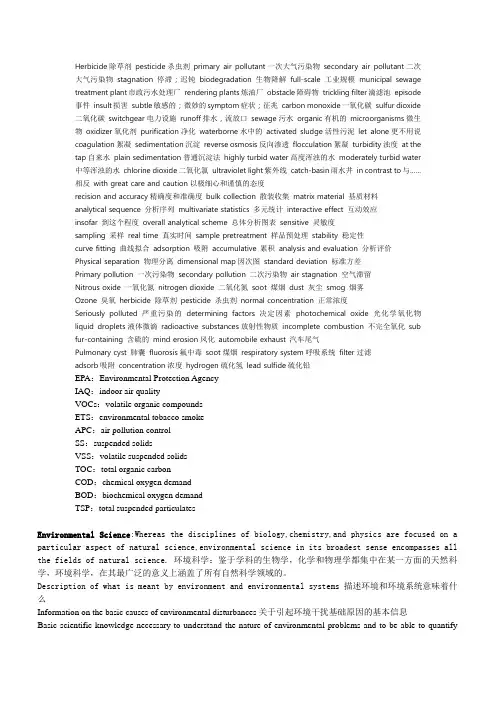
Herbicide除草剂pesticide杀虫剂primary air pollutant一次大气污染物secondary air pollutant二次大气污染物stagnation停滞;迟钝biodegradation生物降解full-scale工业规模municipal sewage treatment plant市政污水处理厂rendering plants炼油厂obstacle障碍物trickling filter滴滤池episode事件insult 损害subtle敏感的;微妙的symptom症状;征兆carbon monoxide一氧化碳sulfur dioxide二氧化碳switchgear电力设施runoff排水,流放口sewage污水organic有机的microorganisms微生物oxidizer 氧化剂purification净化waterborne水中的activated sludge活性污泥let alone更不用说coagulation 絮凝sedimentation沉淀reverse osmosis反向渗透flocculation絮凝turbidity浊度at the tap自来水plain sedimentation普通沉淀法highly turbid water高度浑浊的水moderately turbid water中等浑浊的水chlorine dioxide二氧化氯ultraviolet light紫外线catch-basin雨水井in contrast to与……相反with great care and caution以极细心和谨慎的态度recision and accuracy精确度和准确度bulk collection 散装收集matrix material 基质材料analytical sequence 分析序列multivariate statistics 多元统计interactive effect 互动效应insofar 到这个程度overall analytical scheme 总体分析图表sensitive 灵敏度sampling 采样real time 真实时间sample pretreatment 样品预处理stability 稳定性curve fitting 曲线拟合adsorption 吸附accumulative 累积analysis and evaluation 分析评价Physical separation 物理分离dimensional map因次图standard deviation 标准方差Primary pollution 一次污染物secondary pollution 二次污染物air stagnation 空气滞留Nitrous oxide 一氧化氮nitrogen dioxide 二氧化氮soot 煤烟dust 灰尘smog 烟雾Ozone 臭氧herbicide 除草剂pesticide 杀虫剂normal concentration 正常浓度Seriously polluted 严重污染的determining factors 决定因素photochemical oxide 光化学氧化物liquid droplets液体微滴radioactive substances放射性物质incomplete combustion 不完全氧化sub fur-containing 含硫的mind erosion风化automobile exhaust 汽车尾气Pulmonary cyst 肺囊fluorosis氟中毒soot煤烟respiratory system呼吸系统filter过滤adsorb吸附concentration浓度hydrogen硫化氢lead sulfide硫化铅EPA:Environmental Protection AgencyIAQ:indoor air qualityVOCs:volatile organic compoundsETS:environmental tobacco smokeAPC:air pollution controlSS:suspended solidsVSS:volatile suspended solidsTOC:total organic carbonCOD:chemical oxygen demandBOD:biochemical oxygen demandTSP:total suspended particulatesEnvironmental Science:Whereas the disciplines of biology,chemistry,and physics are focused on a particular aspect of natural science,environmental science in its broadest sense encompasses all the fields of natural science.环境科学:鉴于学科的生物学,化学和物理学都集中在某一方面的天然科学,环境科学,在其最广泛的意义上涵盖了所有自然科学领域的。
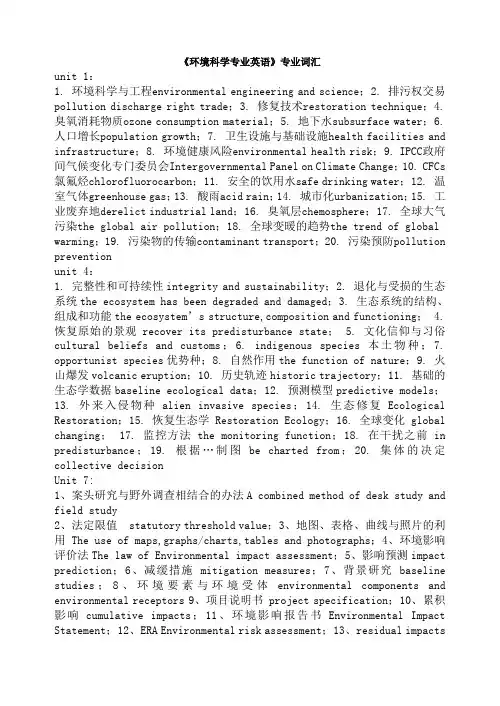
《环境科学专业英语》专业词汇unit 1:1. 环境科学与工程environmental engineering and science;2. 排污权交易pollution discharge right trade;3. 修复技术restoration technique;4. 臭氧消耗物质ozone consumption material;5. 地下水subsurface water;6. 人口增长population growth;7. 卫生设施与基础设施health facilities and infrastructure;8. 环境健康风险environmental health risk;9. IPCC政府间气候变化专门委员会Intergovernmental Panel on Climate Change;10. CFCs 氯氟烃chlorofluorocarbon;11. 安全的饮用水safe drinking water;12. 温室气体greenhouse gas;13. 酸雨acid rain;14. 城市化urbanization;15. 工业废弃地derelict industrial land;16. 臭氧层chemosphere;17. 全球大气污染the global air pollution;18. 全球变暖的趋势the trend of global warming;19. 污染物的传输contaminant transport;20. 污染预防pollution preventionunit 4:1. 完整性和可持续性integrity and sustainability;2. 退化与受损的生态系统the ecosystem has been degraded and damaged;3. 生态系统的结构、组成和功能the ecosystem’s structure,composition and functioning;4. 恢复原始的景观recover its predisturbance state;5. 文化信仰与习俗cultural beliefs and customs;6. indigenous species本土物种;7. opportunist species优势种;8. 自然作用the function of nature;9. 火山爆发volcanic eruption;10. 历史轨迹historic trajectory;11. 基础的生态学数据baseline ecological data;12. 预测模型predictive models;13. 外来入侵物种alien invasive species;14. 生态修复Ecological Restoration;15. 恢复生态学Restoration Ecology;16. 全球变化global changing; 17. 监控方法the monitoring function;18. 在干扰之前in predisturbance;19. 根据…制图be charted from;20. 集体的决定collective decisionUnit 7:1、案头研究与野外调查相结合的办法A combined method of desk study and field study2、法定限值 statutory threshold value;3、地图、表格、曲线与照片的利用 The use of maps,graphs/charts,tables and photographs;4、环境影响评价法The law of Environmental impact assessment;5、影响预测impact prediction;6、减缓措施 mitigation measures;7、背景研究 baseline studies;8、环境要素与环境受体environmental components and environmental receptors9、项目说明书 project specification;10、累积影响cumulative impacts;11、环境影响报告书Environmental Impact Statement;12、ERA Environmental risk assessment;13、residual impacts潜在的影响;14、项目施工期constrution phase;15、可替代的生产技术的选择 Selection of alternative production techniques;16、定性分析与定量分析相结合Combine of qualitative assessment and quantitative assessment;17、基础方案base case 18、监控程序monitoring procedures;19、流程图分析 flow chart analysis;20、事件树分析event tree analysis;Unit 12:1. 城市污水的处理深度;treatment levels of municipal sewage;2. 排放许可 pischarge permits;3. 单元操作;unit oprations;4. 单元过程;unit process;5. 污水预处理;preliminary tereatment of sewage;6. 污水一级处理; primary treatment of sewage;7. 污水二级处理;secondary treatment of sewage;8. 污水三级处理;tertizry treatment of sewage;9. 污水高级处理;advanced treatment of sweage;10. 生物营养物去除;biological nutrient removal;11. 氮和磷;nitrogen and phosphorus;12. BOD;biological oxygen demand;13. TSS total suspended solids; 14. 污水消毒;sweage disinfection;15. VOC volation organic compound挥发性有机物;16. 紫外线消毒;UV radiation disinfection;17. 下水道溢流;sewer verflow;18. 大肠菌; colliform bacteria;19. 回流return flow; 20. 过滤filtration; 21. 城市污水处理厂municipal sewage plants; 22. 市政工程municipal engineering;23. 生物处理系统biological treatment systems;24. 有机物organic matter;25. 工程决断engineering judgement; 26. 当地法规local regulations; 27. 沉降作用sedimentation;28. 可沉淀的颗粒物settleable particles; 29.反渗透reverse osmosis; 30. 膜生物反应器membrane bioreactors; 31. 涡流分流器vortex separators;32. 污水净化sewage clarification; 33. 超滤ultrafiltration; 34.出水水质water quality of effluent;35. 富营养化nutrientenrichment/eutrophication;36. 点源污染point source pollution; 37. 面源污染(非点源污染)nonpoint source pollution; 38.老化的基础设施aging infrastructure; 39. 紫外灯UV lamp; 40. 土地处理过程land treatment process。
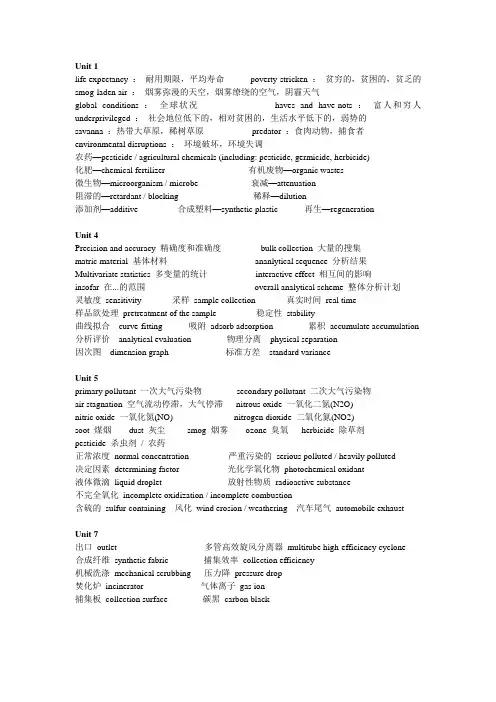
life expectancy :耐用期限,平均寿命poverty-stricken :贫穷的,贫困的,贫乏的smog-laden air :烟雾弥漫的天空,烟雾缭绕的空气,阴霾天气global conditions :全球状况haves and have-nots :富人和穷人underprivileged :社会地位低下的,相对贫困的,生活水平低下的,弱势的savanna :热带大草原,稀树草原predator :食肉动物,捕食者environmental disruptions :环境破坏,环境失调农药—pesticide / agricultural chemicals (including: pesticide, germicide, herbicide)化肥—chemical fertilizer 有机废物—organic wastes微生物—microorganism / microbe 衰减—attenuation阻滞的—retardant / blocking 稀释—dilution添加剂—additive 合成塑料—synthetic plastic 再生—regenerationUnit 4Precision and accuracy 精确度和准确度bulk collection 大量的搜集matric material 基体材料ananlytical sequence 分析结果Multivariate statistics 多变量的统计interactive effect 相互间的影响insofar 在...的范围overall analytical scheme 整体分析计划灵敏度sensitivity 采样sample collection 真实时间real time样品欲处理pretreatment of the sample 稳定性stability曲线拟合curve-fitting 吸附adsorb adsorption 累积accumulate accumulation 分析评价analytical evaluation 物理分离physical separation因次图dimension graph 标准方差standard varianceUnit 5primary pollutant 一次大气污染物secondary pollutant 二次大气污染物air stagnation 空气流动停滞,大气停滞nitrous oxide 一氧化二氮(N2O)nitric oxide 一氧化氮(NO) nitrogen dioxide 二氧化氮(NO2)soot 煤烟dust 灰尘smog 烟雾ozone 臭氧herbicide 除草剂pesticide 杀虫剂/ 农药正常浓度normal concentration 严重污染的serious polluted / heavily polluted决定因素determining factor 光化学氧化物photochemical oxidant液体微滴liquid droplet 放射性物质radioactive substance不完全氧化incomplete oxidization / incomplete combustion含硫的sulfur-containing 风化wind erosion / weathering 汽车尾气automobile exhaustUnit 7出口outlet 多管高效旋风分离器multitube high-efficiency cyclone合成纤维synthetic fabric 捕集效率collection efficiency机械洗涤mechanical scrubbing 压力降pressure drop焚化炉incinerator 气体离子gas ion捕集板collection surface 碳黑carbon black尾气off-gas 可应用性applicability 工业规模full-scale 土壤床soil bed生物过滤器biofilter 固定资本fixed capital 易生物降解的easily biodegraded VOC 挥发性有机化合物APC 大气污染控制Regulatory program 调整项目Financial support 财政支持Operating cost 操作成本Biodegradation capacity 生物降解能力Environmental media 环境介质Biological 生物学的Technologies 技术、工艺Inorganic air pollutants 无机大气污染物Unit 10treatment facilities 处理设备municipality 市政当局, 自治市population equivalent 人口当量basement flooding 地下室浸水per capita per day 每人每天runoff 排水domestic sewage 生活污水type of terrain 地形种类Unit 12land disposal 掩埋处置fecal coliform 粪大肠菌群stringent effluent requirement 严格的废水排放要求assimilation capacity 同化能力practical outlets 可行的排出途径,现实出路aquatic life 水生生物detrimental to human health 对人体健康有害的endogenous phase 内源〔生长〕期Unit 13flow monitoring 流量监测equipment age and reliability 装备老化及其可靠性mechanistic facilities 机械设备microbial activity 微生物活性activated sludge 活性污泥controlling respiration 控制呼吸oxidation ditches 氧化沟on-line automation 在线自动〔监测〕手动控制operator control/ manual control 最优化minimize the effects微处理器microprocessor 统计分析statistical analysis质量衡算mass balance 动力学dynamics氧化还原oxidation and reduction /redox 停留时间residence time模拟simulation 参数parameter 水解hydrolysis 积分integralUnit 1 环境工程本书的内容:本书的目的是使工科和理科学生对环境问题的跨学科的研究有所了解:环境问题的起因,环境问题受关注的原因,如何控制环境问题。

专业英语环境:environment环境工程:environmentalengineering环境保护:environmentalprotection环境意识:environmentalconsciousness/awareness环境问题:environmentalissue/problem环境效应:environmentaleffect环境污染:environmentalpollution环境要素:environmentalelements环境因子:environmentalfactors环境化学:environmentalchemistry环境生态学:environmentalecology环境质量:environmentalquality环境自净作用:environmentalself-purification/self-cleansing 水环境:watershed水体:waterbody流域:watershed水质:waterquality水资源:waterresources供水:watersupply废水:wastewater水处理:watertreatment物理性水质指标:physicalindicateofwaterquality水污染物:waterpollutant生物性水质指标:biologicalwater-qualityindex水质标准:waterqualitystandard化学性水质指标:chemicalwater-qualityindexDS:dissolvedsolidsBOD:biochemicaloxygendemandTDS:totaldissolvedsolidsCOD:chemicaloxygendemand TSS:totalsuspendedsolidsDO:dissolvedoxygenTOC:totalorganiccarbonPH值:TN:总氮totalnitrogenTP:总磷phosphorusZn:zincCu:CopperAs:arsenicCd:CadmiumCr:chromiumNi:NickelHg:mercuryPb:plumbum物理处理:physicaltreatment过滤:screening生物处理:biologicaltreatment沉淀:sedimentation化学处理:chemicaltreatment气浮:flotation物理化学处理:physical-chemicaltreatment蒸发:evaporation稀释:dilution扩散:dispersion吹脱:stripping好氧处理:aerobictreatment生物膜法:bio-membraneprocess 厌氧处理:anaerobictreatment生物滤池:tricklingfilters 活性污泥法:activatedsludgeprocess生物接触氧化:biologicalcontactSBR:苯乙烯-丁二烯StyreneButadieneRubberUASB(流式厌氧污泥床):Upflowanaerobicsludgeblanket活性污泥:activatedsludge改进型:modification一级处理:primarytreatment二级处理:secondarytreatment三级处理:tertiarytreatment高级氧化处理:advancedtreatment生活污水:domesticwastewater 生产废水:industrialwastewater城市生活污水:municipalwastewater电镀废水:metalplatingplants印染废水:pulpandpaperindustrieswastewater浊度:turbidity 硬度:hardness水质净化:waterqualitypurifies混凝沉淀:coagulateflocculatingagent活性炭吸附:activatedcarbonadsorption隔油池:oilseparationtank中和池:neutralizationtank调节池:adjustingtank生物反应池:biologicalreactor加药设备:physicalequipment沉淀池:sedimentationtank初沉池:primarysedimentationtank二沉池:secondarysedimentationtank絮凝剂:flocculant混凝剂:coagulateflocculant生物降解:biodegradation生物累积:bioaccumulation飘尘:floatingdust可吸入颗粒物:inhalableparticles能见度:visibility酸雨:acidrain一次污染物:primarypollutant二次污染物:secondarypollutant氮氧化物:nitrogenoxides 硫氧化物:sulfuroxides硫化氢:hydrogensulfide碳氧化物:carbonoxides硝酸:nitricacid盐酸:hydrochloricacid硫酸:sulfuricacid二氧化硫:sulfurdioxide除尘工艺:Dustremoval吸收:absorption吸附:adsorption静电除尘:electricdustprecipitation重力除尘:gravitationalsettling臭氧:ozone光化学烟雾:photochemicalsmoke喷淋(洗涤):scavenging 土壤:soil热污染:temperaturechange/thermalpollution 噪声:noise放射性:radioactivityEIA:environmentalimpactassessmen tCAD(计算机辅助设计):computeraideddesign大气污染控制工程:airpollutioncontrol水污染控制工程:waterpollutioncontrol 固体废物污染控制工程:solidwastemanagement污染源:pollutionsource同化作用:assimilation固体废物:solidwastes危险废物:hazardouswastes 化学污泥chemicalsludge:生物污泥:biologicalsludge工业固废:industrialwastes分选处理:separationtreatment 矿业固废:minesolidwastes破碎处理:processing农业固废:agriculturesolidwastes压实处理:reductioninvolume污泥脱水:disposalofthesludge?污泥浓缩:sludgethickening 带式压滤:Beltfilterpress 离心脱水:centrifugaldewatering 筛分:screening堆肥和堆肥化:compostandcomposting沼气和沼气化:biogas热解与焚烧:pyrolysisandincineration 生物转化作用:biotransformation热化学转化作用:thermo-chemical固化和稳定化作用:solidificationandstabilizati on资源化:resource减量化:pollutioncontrol无害化:harmlessness固体废物全过程控制:solidwasteintegratedcontrol 固体废物污染控制:solidwasterpollutioncontrol 固体废物处理:processingandrecovery处置:disposal物质回收:materialsrecovery 物质转化:materialconversion 能量回收:energyrecovery能量转化:energyconversion1.Environmentalengineeringhasbeendefinedasthebranchofengineeringthatisconcernedwithprotectingtheenvironmentfromthepotential,deleteriouseffectsofhumanactivity,protectinghuman populationsfromtheeffectsofadverseenvironmentalfactors,andimprovingenvironmentalqualit yforhumanhealthandwell-being.(2页)环境工程学是环境工程的分支学科,其研究内容包括①保护环境免受人类活动改造形成的潜在和不利影响②保护人类免受不利环境因素的影响③持续改善环境质量,以造福于人类健康与福祉。
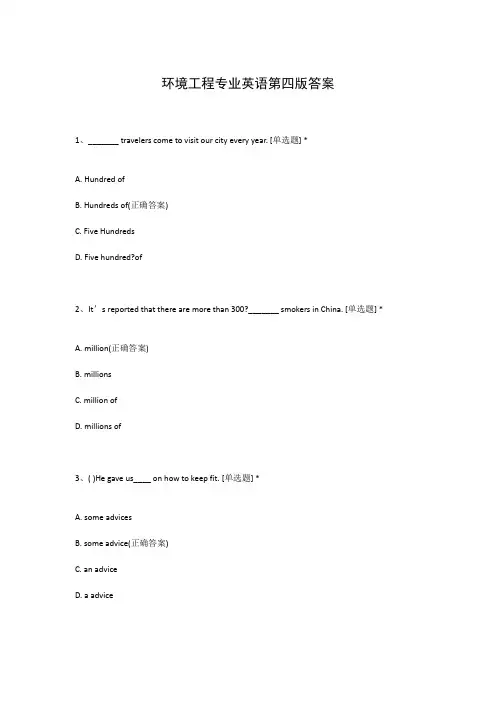
环境工程专业英语第四版答案1、_______ travelers come to visit our city every year. [单选题] *A. Hundred ofB. Hundreds of(正确答案)C. Five HundredsD. Five hundred?of2、It’s reported that there are more than 300?_______ smokers in China. [单选题] *A. million(正确答案)B. millionsC. million ofD. millions of3、( )He gave us____ on how to keep fit. [单选题] *A. some advicesB. some advice(正确答案)C. an adviceD. a advice4、She _______ so much _______ her mother. [单选题] *A. looks; like(正确答案)B. looks; forC. looks; afterD. looks forwards; to5、Researchers have spent five years collecting data()the study is based. [单选题] *A. on thatB. in whichC. in thatD. on which(正确答案)6、Last week they _______ in climbing the Yuelu Mountain. [单选题] *A. succeeded(正确答案)B. succeedC. successD. successful7、I’d like to know the _______ of the club. [单选题] *A. schedule(正确答案)C. menuD. subject8、The weather forecast says that we’ll have occasional rain tomorrow. [单选题] *A. 偶尔的B. 不停的C. 少量的(正确答案)D. 不可预测的9、—Where did you get the book?—From my friend. I ______ it three days ago. ()[单选题] *A. lentB. borrowed(正确答案)C. keptD. returned10、Wang Dong usually gets up at 6:00 _______ he can catch the early school bus. [单选题] *A. as ifB. so that(正确答案)C. until11、23.Hurry up! The train ________ in two minutes. [单选题] *A.will go(正确答案)B.goC.goesD.went12、This is _________ my father has taught me—to always face difficulties and hope for the best. [单选题] *A. howB. whichC. that(正确答案)D. what13、Leave your key with a neighbor ___ you lock yourself out one day [单选题] *A. ever sinceB. even ifC. soon afterD. in case(正确答案)14、He went to America last Friday. Alice came to the airport to _______ him _______. [单选题] *A. take; offB. see; off(正确答案)C. send; upD. put; away15、There is a bank ______ the street. [单选题] *A. on the end ofB. in the end ofC. at the end of(正确答案)D. by the end of16、8.Turn right ________ Danba Road and walk ________ the road, then you will findMeilong Middle school. [单选题] *A.in...alongB.into...along (正确答案)C.in...onD.into...on17、The beautiful radio _______ me 30 dollars. [单选题] *A. spentB. paidC. cost(正确答案)D. took18、The market economy is quickly changing people’s idea on_____is accepted. [单选题] *A.what(正确答案)B.whichC.howD.that19、How lovely a day,()? [单选题] *A. doesn't itB. isn't it(正确答案)C.shouldn't itD.hasn't it20、Could you please ______ why you can’t come to attend the meeting? [单选题] *A. explain(正确答案)B. understandC. giveD. reach21、Bliss, who worked in an information centre, began to work on the book in 1 [单选题] *A. 策划B. 上班C. 写作(正确答案)D. 销售22、The notice put _______ on the wall says “No Smoking”. [单选题] *A. up(正确答案)B. offC. awayD. out23、—When are you going to Hainan Island for a holiday? —______ the morning of 1st May.()[单选题] *A. InB. AtC. On(正确答案)D. For24、Seldom _____ in such a rude way. [单选题] *A.we have been treatedB. we have treatedC. have we been treated(正确答案)D. have treated25、I hope to see you again _______. [单选题] *A. long long agoB. long beforeC. before long(正确答案)D. long26、—Judging from ____ number of bikes, there are not many people in the party.—I think so. People would rather stay at home in such _____ weather. [单选题] *A. the, aB. a, /C. the, /(正确答案)D. a, a27、The house was completed five months ago. [单选题] *A. 完成(正确答案)B. 复杂C. 开始D. 装着28、In the future, people ______ a new kind of clothes that will be warm when they are cold, and cool when they’re hot.()[单选题] *A. wearB. woreC. are wearingD. will wear(正确答案)29、Galileo was ____ Italian physicist and astronomer who invented _____ telescope. [单选题] *A. a, aB. the, theC. an, aD. an, the(正确答案)30、I'm sorry I cannot see you immediately. But if you wait, I'll see you_____. [单选题] *A. for a momentB. in a moment(正确答案)C. for the momentD. at the moment。
晓庄学院期末考试试卷 ( 07 级 环境工程 专业2010 ~2011 学年度 第 一 学期) 课程名称 环境工程专业英语 ✌ 卷 考试形式 闭卷 考核类型 考试 本试卷共 六 大题,卷面满分 分,答题时间 分钟。
一、 请根据缩写写出单词全称:(本题共 小题,每小题 分,共 分) ✞:✞☐●♋♦♓●♏ ❒♑♋⏹♓♍ ☐❍☐☐◆⏹♎♦ ✌:✌♓❒ ☐●●◆♦♓☐⏹ ☐⏹♦❒☐● : ◆♦☐♏⏹♎♏♎ ☐●♓♎♦ : ♒♏❍♓♍♋● ⌧⍓♑♏⏹ ♏❍♋⏹♎ ☜✋✌: ☜⏹❖♓❒☐⏹❍♏⏹♦♋● ✋❍☐♋♍♦ ✌♦♦♏♦♦❍♏⏹♦ (评分标准:每小题中单词全部写对,不论大小写,得 分;错一个单词得 分;错两个及以上单词,得 分。
)二、 请写出下列术语的英文表达:(本题共 小题,每小题 分,共 分) 城市污水:❍◆⏹♓♍♓☐♋● ♦♋♦♦♏♦♋♦♏❒废水处理:♦♋♦♦♏♦♋♦♏❒ ♎♓♦☐☐♦♋● 沉降池 ♦♏♎♓❍♏⏹♦♋♦♓☐⏹ ♦♋⏹ 消毒 ♎♓♦♓⏹♐♏♍♦♓☐⏹ 絮凝作用 ♐●☐♍♍◆●♋♦♓☐⏹(评分标准:每小题中所用单词意思基本吻合,单词拼写正确,且单词词态正确,得 分;错一个单词得 分;错两个及以上单词,得 分。
)三、 请根据下列英文解释写出相应的英文词汇:(本题共 小题,每题 分,共 分)❆♒♏ ☐♒⍓♦♓♍♋● ♋⏹♎ ♌♓☐♦♓♍ ♒♋♌♓♦♋♦♦♒♓♍♒ ♦◆❒❒☐◆⏹♎♦ ◆♦ ☜⏹❖♓❒☐⏹❍♏⏹♦ ✌ ⏹♋♦◆❒♋● ♑♋♦ ♦♒♓♍♒ ♓♦ ♐☐❒❍♏♎ ♐❒☐❍ ♎♏♍♋⍓♓⏹♑ ❍♋♦♦♏❒ ♋⏹♎ ♌◆❒⏹♦ ♏♋♦♓●⍓ ♦☐❍♏♦♓❍♏♦ ♍♋◆♦♏♦ ♏⌧☐●☐♦♓☐⏹♦ ♓⏹ ❍♓⏹♏♦ ♏♦♒♋⏹♏❆☐☐ ❍♋⏹⍓ ☐♏☐☐●♏ ♓⏹ ♋ ♑♓❖♏⏹ ♋❒♏♋♦☐☐ ♒♓♑♒ ♋ ☐☐☐◆●♋♦♓☐⏹ ♎♏⏹♦♓♦⍓ ❖♏❒☐☐☐◆●♋♦♓☐⏹❆♒♏ ☐❒☐♍♏♦♦ ♌⍓ ♦♒♓♍♒ ♦♋♦♏❒ ☐♋♦♦♏♦ ♦♒❒☐◆♑♒ ♋ ❍♏❍♌❒♋⏹♏ ♦♒♋♦ ♓♦ ♓❍☐♏❒❍♏♋♌●♏ ♦☐ ♎♓♦♦☐●❖♏♎ ♓☐⏹♦♦❍☐♦♓♦✌ ♓⏹♎ ☐♐ ♍♒♏❍♓♍♋● ♦♒♓♍♒ ♍♋⏹ ♦☐♏♏♎ ◆☐♎☐♦⏹ ♋ ♍♒♏❍♓♍♋● ❒♏♋♍♦♓☐⏹ ❒♋♦♏♋♦♋●⍓♦♦(评分标准:每小题中所用单词意思基本吻合,单词拼写正确,且单词词态正确,得 分;否则得 分。
环境工程专业重点英语单词1. Environment (n): The natural world and the surroundings in which people, animals, and plants live.Example: We need to protect the environment for future generations.2. Engineering (n): The branch of science and technology concerned with the design, building, and use of engines, machines, and structures.Example: He studied engineering at university.3. Pollution (n): The presence or introduction into the environment of substances or energy that cause harm or discomfort to living organisms. Example: Air pollution is a major problem in many cities.4. Sustainable (adj): Able to be maintained at a certain rate or level over time.Example: The company is committed to sustainable development.5. Waste (n): Material that is not wanted; the act of using or expending something carelessly, extravagantly, or to no purpose.Example: We need to find a better way to dispose of waste.6. Treatment (n): The application of medical or therapeutic measures to a patient.Example: The water treatment plant ensures clean drinking water for the community.7. Contamination (n): The presence of harmful or unwanted substances in an environment or substance.Example: The contamination of the river has caused the fish population to decline.8. Conservation (n): The act of preserving, protecting, or restoring the natural environment, natural ecosystems, vegetation, and wildlife. Example: The national park is dedicated to the conservation of endangered species.9. Renewable (adj): Capable of being replenished or replaced by natural processes within a human lifetime.Example: Solar energy is a renewable source of power.10. Emission (n): The production and discharge of something, especially gas or radiation.Example: The factory's emissions are contributing to air pollution.11. Remediation (n): The action of remedying something, in particular of reversing or stopping environmental damage.Example: The soil remediation process will remove contaminants from the site.12. Efficiency (n): The state or quality of being efficient, in which maximum productivity is achieved with minimum wasted effort or expense.Example: The new lighting system improves energy efficiency.13. Sanitation (n): The provision of clean drinking water and adequate sewage disposal to promote public health.Example: Access to proper sanitation facilities is essential for preventing disease.14. Biodegradable (adj): Capable of being decomposed by bacteria or other living organisms.Example: It is important to use biodegradable products to reduce waste.15. Conservationist (n): A person who advocates or acts for the protection and preservation of the environment and wildlife.Example: Jane Goodall is a well-known conservationist.16. Hazardous (adj): Involving risk or danger, especially to someone's health or safety.Example: The storage of hazardous materials requires special precautions.17. Renewable energy (n): Energy collected from resources that are naturally replenished, such as sunlight, wind, and water.Example: Many countries are investing in renewable energy sources to reduce reliance on fossil fuels.18. Ecosystem (n): A biological community of interacting organisms and their physical environment.Example: The destruction of forests has a negative impact on the ecosystem.19. Biodiversity (n): The variety and variability of life forms within a given area.Example: Protecting biodiversity is crucial for maintaining a healthy planet.20. Toxic (adj): Poisonous; harmful to living organisms.Example: Industrial waste often contains toxic chemicals.21. Effluent (n): Liquid waste or sewage discharged into a river or the sea. Example: The treatment plant ensures that effluent is properly treated before being released.22. Conservationism (n): The philosophy and movement advocating for the protection of the environment and natural resources.Example: Conservationism aims to balance human needs with the preservation of nature.23. Remedial action (n): Steps taken to correct or mitigate a problem or damage.Example: The company implemented remedial actions to address the environmental contamination.24. Greenhouse effect (n): The trapping of the sun's warmth in a planet's atmosphere due to the increased concentration of greenhouse gases.Example: The greenhouse effect is causing global warming.25. Incineration (n): The process of burning waste materials, often for the purpose of generating energy.Example: Incineration can be an effective method of waste disposal when done properly.26. Acid rain (n): Rainfall that has been made acidic by pollution, especially from the combustion of fossil fuels.Example: Acid rain can have detrimental effects on ecosystems and infrastructure.27. Biomass (n): Organic matter, such as plant material and animal waste, that can be used as a source of energy.Example: Biomass can be converted into biofuel for power generation.28. Soil erosion (n): The removal of soil by wind or water, often caused by human activities or natural processes.Example: Deforestation contributes to soil erosion.29. Ecological footprint (n): The impact of human activities on theenvironment, measured in terms of the amount of land and resources required to sustainably support those activities.Example: By reducing our ecological footprint, we can minimize our impact on the planet.30. Waste management (n): The collection, transportation, processing, recycling, and disposal of waste materials.Example: Proper waste management is essential for protecting the environment and public health.31. Landfill (n): A site for the disposal of waste materials by burying them under layers of earth.Example: Recycling reduces the amount of waste sent to landfills.32. Air quality (n): The degree to which the air is free from pollutants, contaminants, and odors.Example: Monitoring air quality is crucial for public health.33. Environmental impact assessment (n): The evaluation of the likely environmental consequences of a proposed project or action.Example: An environmental impact assessment is required before starting construction on a new development.34. Ozone depletion (n): The reduction in the concentration of ozone in the Earth's ozone layer, primarily caused by the release of certain chemicals into the atmosphere.Example: The Montreal Protocol was established to address ozone depletion.35. Land degradation (n): The decline in the quality of land, often caused by human activities such as deforestation and agriculture.Example: Land degradation can lead to desertification.36. Wastewater treatment (n): The process of removing contaminants from wastewater before it is discharged back into the environment.Example: Wastewater treatment plants play a crucial role in protecting water resources.37. Marine pollution (n): The contamination of the marine environment, usually by human activities such as oil spills and dumping of waste.Example: Marine pollution can have devastating effects on marine ecosystems.38. Noise pollution (n): Excessive or constant noise that is disruptive or harmful to humans and animals.Example: Noise pollution from traffic can negatively impact human health.39. Ecosystem services (n): The benefits that people obtain from ecosystems, such as clean air and water, pollination, and climate regulation.Example: Preserving forests is important for maintaining ecosystem services.40. Industrial waste (n): Waste generated by industrial processes, often containing hazardous substances.Example: Proper disposal of industrial waste is crucial for preventing environmental contamination.41. Emission control (n): Measures taken to reduce the discharge of pollutants into the environment.Example: Stricter emission control regulations have led to cleaner air in many cities.42. Nonrenewable (adj): Not capable of being replenished or replaced within a reasonable time frame.Example: Fossil fuels are nonrenewable resources.43. Waste reduction (n): The act of minimizing the amount of waste generated through source reduction, recycling, and reuse.Example: Waste reduction strategies aim to reduce landfill waste.44. Environmental ethics (n): A branch of philosophy that considers the moral obligations humans have towards the environment and non-human living entities. Example: Environmental ethics advocate for the rights of animals and the preservation of natural habitats.45. Water scarcity (n): The lack of sufficient water resources to meet the needs of a population or region.Example: Climate change is exacerbating water scarcity in many parts of the world.46. Renewable resource (n): A natural resource that can be replenished or replaced by natural processes within a human lifetime.Example: Solar power is derived from a renewable resource.47. Environmental impact (n): The effect of human activities on theenvironment, including both positive and negative consequences.Example: A construction project must consider its environmental impact.48. Acidification (n): The process of becoming more acidic, often caused by increased carbon dioxide levels in the atmosphere.Example: Ocean acidification poses a threat to marine life.49. Ecotourism (n): Tourism that involves responsible travel to natural areas, with an emphasis on conserving the environment and improving the well-being of local communities.Example: Ecotourism promotes sustainable tourism practices.50. E-waste (n): Electronic waste, such as obsolete computers, mobile phones, and televisions, that is discarded by consumers.Example: It is important to properly dispose of e-waste to prevent environmental contamination.。
环境工程专业英语pollution污染acid rain 酸雨environmental problem 环境问题environmental disturbance环境损坏biotic habitat 生物环境sulfur dioxide二氧化硫nitrogen oxide氧化氮carbon dioxide二氧化碳automobile exhaust汽车尾气infectious diseases 有传染性的疾病waterborne diseases 水传染的疾病 agrarian society农业社会 industrial society工业社会 industrial revolution家产革命urbanization城市化industrialization工业化developed country 发达国家developing country 发展中国家 undeveloped country 落伍国家 primary air pollutant一次大气污染物 secondary air pollutant 二次大气污染物monoxide 一氧化物 dioxide 二氧化物 trioxide 三氧化物 carbon monoxide一氧化碳 carbon dioxide 二氧化碳sulfur dioxide 二氧化硫sulfur trioxide 三氧化硫 nitrous oxide 一氧化二氮 nitric oxide 一氧化氮nitrogen dioxide二氧化氮carbon oxides 碳氮化物sulfur oxides 硫氧化物nitrogen oxides 氮氧化物hydrocarbons 碳氢化合物 photochemical oxidants 光化学氧化物 particulates 颗粒物inorganic compound 无机化合物 organic compound 有机化合物 radioactive substance放射性物质heat 热noise噪声 contaminant污染物strength 强度foreign matter杂质domestic sewage生活污水municipalwastewater城市废水microbe微生物microorganism微生物bacteria细菌total solids总固体inorganic constituents无机因素suspended solids(SS)固体悬浮物volatile s uspended solids(VSS)挥发性悬浮固体颗粒organic matter 有机物质total organic carbon, TOC 总有机碳chemical oxygen demand, COD 化学需氧量biochemical oxygen demand,BOD 生化需氧量biodegradable 可微生物分解的 contamination 污染recontamination 再污染groundwater地下水surface water 地表水 restriction 限制colloid 胶体 screening隔栅coagulation凝聚flocculation絮凝sedimentation 积淀filtration过滤disinfection消毒chlorination氯化消毒prechlorination预加氯ozonation臭氧消毒aeration 曝气softening 融化activated carbon 活性炭 adsorption吸附reverse osmosis 反浸透desalination脱盐处理microbial degradation微生物降解biological degradation生化降解biofilm process 生物膜法activated sludge process活性污泥法attached -growth 吸着生长 suspended-growth 悬浮生长 shock loading 冲击负荷organic loading 有机负荷 mixed liquor suspended solids 混淆液悬浮固体metabolize使代谢化metabolism新陈代谢dissolved oxygen 溶解氧pretreatment process 预办理工艺primary clarifier 初沉池 equalization basin 均质池 biological treatment process生物处理工艺 aeration basin 曝气池secondary clarifier二沉池 biomass生物质 heterotrophic bacteria异养菌autotrophic bacteria自养菌hydraulic retention time(HRT) 水力逗留时间sludge residence time (SRT) 污泥逗留时间solid waste 固体废物municipal 城市化industrial工业的agricultural 农业的hazardous 危险的residential住所的commercial 商业的 putrescible 易腐化的combustible易燃的flammable可燃的 explosive易爆的radioactive放射性的Landfilling土地填埋incineration:焚烧composting:堆肥compaction:压实,紧凑sanitary landfill 卫生填埋balance 剩下的,余额,结余batch-fed 分批投料refuse 垃圾municipal waste 城市垃圾perform:执行shut down:关闭energy recovery 能量回收 incomplete combustion不完整焚烧combustion燃烧volume reduction体积减小anaerobic厌氧硝化中英互译短语Biological degradation 生化降解equalization basin 调理池aeration basin 曝气池sludge blocs 污泥絮体settling tank积淀池dissolved oxygen溶解氧 suspended-growth悬浮生长pulverized refuse垃圾破裂biofilm 生物膜well -compacted landfill压实填埋场nutrient source 营养源mass-burning 大批焚烧 fluidized fed incarceration 硫化床焚烧法soil conditioners 土壤改进剂温室效应 greenhouse effect由 CO2惹起的 caust by CO2世界碳估算 the world carbon budget天气自然颠簸 natural fluctuations全世界变暖 global warming 厌氧的 anaerobic腐化 Putrefied甲烷 methane 臭氧层 ozone layer天气模型 climatic model 正常浓度: normal concentration严重污染物: heavily polluted决定因素: determining factor光化学氧化物:photochemical oxidants液体微滴:liquid particulates含硫的: sulfur -containing放射性物质: radioactiue substance 汽车尾气: automobile exhaust wet oxidation湿式氧化1、 Environment is the physical and biotic habitat which surrounds us; that which we can see, hear, touch,smell, and taste.环境是我们四周的物理和生物环境,我们能够看到、听到、接触到、闻到和品味到的。
Herbicide除草剂pesticide杀虫剂primary air pollutant一次大气污染物secondary air pollutant二次大气污染物stagnation停滞;迟钝biodegradation生物降解full-scale工业规模municipal sewage treatment plant市政污水处理厂rendering plants炼油厂obstacle障碍物trickling filter滴滤池episode事件insult 损害subtle敏感的;微妙的symptom症状;征兆carbon monoxide一氧化碳sulfur dioxide二氧化碳switchgear电力设施runoff排水,流放口sewage污水organic有机的microorganisms微生物oxidizer 氧化剂purification净化waterborne水中的activated sludge活性污泥let alone更不用说coagulation 絮凝sedimentation沉淀reverse osmosis反向渗透flocculation絮凝turbidity浊度at the tap自来水plain sedimentation普通沉淀法highly turbid water高度浑浊的水moderately turbid water中等浑浊的水chlorine dioxide二氧化氯ultraviolet light紫外线catch-basin雨水井in contrast to与……相反with great care and caution以极细心和谨慎的态度recision and accuracy精确度和准确度bulk collection 散装收集matrix material 基质材料analytical sequence 分析序列multivariate statistics 多元统计interactive effect 互动效应insofar 到这个程度overall analytical scheme 总体分析图表sensitive 灵敏度sampling 采样real time 真实时间sample pretreatment 样品预处理stability 稳定性curve fitting 曲线拟合adsorption 吸附accumulative 累积analysis and evaluation 分析评价Physical separation 物理分离dimensional map因次图standard deviation 标准方差Primary pollution 一次污染物secondary pollution 二次污染物air stagnation 空气滞留Nitrous oxide 一氧化氮nitrogen dioxide 二氧化氮soot 煤烟dust 灰尘smog 烟雾Ozone 臭氧herbicide 除草剂pesticide 杀虫剂normal concentration 正常浓度Seriously polluted 严重污染的determining factors 决定因素photochemical oxide 光化学氧化物liquid droplets液体微滴radioactive substances放射性物质incomplete combustion 不完全氧化sub fur-containing 含硫的mind erosion风化automobile exhaust 汽车尾气Pulmonary cyst 肺囊fluorosis氟中毒soot煤烟respiratory system呼吸系统filter过滤adsorb吸附concentration浓度hydrogen硫化氢lead sulfide硫化铅EPA:Environmental Protection AgencyIAQ:indoor air qualityVOCs:volatile organic compoundsETS:environmental tobacco smokeAPC:air pollution controlSS:suspended solidsVSS:volatile suspended solidsTOC:total organic carbonCOD:chemical oxygen demandBOD:biochemical oxygen demandTSP:total suspended particulatesEnvironmental Science:Whereas the disciplines of biology,chemistry,and physics are focused on a particular aspect of natural science,environmental science in its broadest sense encompasses all the fields of natural science.环境科学:鉴于学科的生物学,化学和物理学都集中在某一方面的天然科学,环境科学,在其最广泛的意义上涵盖了所有自然科学领域的。
环境工程专业英语pollution污染acid rain酸雨environmental problem 环境问题environmental disturbance环境破坏biotic habitat 生物环境sulfur dioxide二氧化硫nitrogen oxide氧化氮carbon dioxide二氧化碳automobile exhaust汽车尾气infectious diseases有传染性的疾病waterborne diseases水传染的疾病agrarian society农业社会industrial society工业社会industrial revolution产业革命urbanization城市化industrialization工业化developed country发达国家developing country发展中国家undeveloped country落后国家primary air pollutant一次大气污染物secondary air pollutant二次大气污染物monoxide一氧化物dioxide二氧化物trioxide三氧化物carbon monoxide一氧化碳carbon dioxide二氧化碳sulfur dioxide二氧化硫sulfur trioxide三氧化硫nitrous oxide一氧化二氮nitric oxide一氧化氮nitrogen dioxide二氧化氮carbon oxides碳氮化物sulfur oxides硫氧化物nitrogen oxides氮氧化物hydrocarbons碳氢化合物photochemical oxidants光化学氧化物particulates颗粒物inorganic compound无机化合物organic compound有机化合物radioactive substance放射性物质heat热noise噪声contaminant污染物strength强度foreign matter杂质domestic sewage生活污水municipalwastewater城市废水microbe微生物microorganism微生物bacteria细菌total solids总固体inorganic constituents无机要素suspended solids (SS)固体悬浮物volatile suspended solids (VSS)挥发性悬浮固体颗粒organic matter有机物质total organic carbon, TOC 总有机碳chemical oxygen demand, COD化学需氧量biochemical oxygen demand, BOD生化需氧量biodegradable可微生物分解的contamination污染recontamination再污染groundwater地下水surface water地表水restriction限制colloid胶体screening隔栅coagulation凝聚flocculation絮凝sedimentation沉淀filtration过滤disinfection消毒chlorination氯化消毒prechlorination预加氯ozonation臭氧消毒aeration曝气softening软化activated carbon活性炭adsorption吸附reverse osmosis反渗透desalination脱盐处理microbial degradation微生物降解biological degradation生化降解biofilm process生物膜法activated sludge process活性污泥法attached-growth吸着生长suspended-growth悬浮生长shock loading冲击负荷organic loading有机负荷mixed liquor suspended solids混合液悬浮固体metabolize使代谢化metabolism新陈代谢dissolved oxygen 溶解氧pretreatment process 预处理工艺primary clarifier初沉池equalization basin均质池biological treatment process生物处理工艺aeration basin曝气池secondary clarifier二沉池biomass生物质heterotrophic bacteria异养菌autotrophic bacteria自养菌hydraulic retention time (HRT) 水力停留时间sludge residence time (SRT) 污泥停留时间solid waste固体废物municipal城市化industrial工业的agricultural农业的hazardous危险的residential住宅的commercial商业的putrescible易腐烂的combustible易燃的flammable可燃的explosive易爆的radioactive放射性的Landfilling土地填埋incineration: 焚烧composting: 堆肥compaction: 压实,紧凑sanitary landfill卫生填埋balance剩下的,余额,结余batch-fed 分批投料refuse垃圾municipal waste城市垃圾perform: 执行shut down: 关闭energy recovery能量回收incomplete combustion不完全燃烧combustion燃烧volume reduction体积缩小anaerobic厌氧硝化中英互译短语Biological degradation生化降解equalization basin调节池aeration basin曝气池sludge blocs 污泥絮体settling tank沉淀池dissolved oxygen溶解氧suspended-growth悬浮生长pulverized refuse垃圾破碎biofilm生物膜well-compacted landfill压实填埋场nutrient source 营养源mass-burning大量燃烧fluidized fed incarceration硫化床燃烧法soil conditioners土壤改良剂温室效应greenhouse effect 由CO2引起的caust by CO2 世界碳预算the world carbon budget 天气自然波动natural fluctuations 全球变暖global warming 厌氧的anaerobic 腐烂Putrefied 甲烷methane 臭氧层ozone layer 气候模型climatic model 正常浓度:normal concentration 严重污染物:heavily polluted 决定因素:determining factor 光化学氧化物:photochemical oxidants 液体微滴:liquid particulates 含硫的:sulfur-containing 放射性物质:radioactiue substance 汽车尾气:automobile exhaust wet oxidation湿式氧化1、Environment is the physical and biotic habitat which surrounds us; that which we can see, hear, touch, smell, and taste. 环境是我们周围的物理和生物环境,我们可以看到、听到、接触到、闻到和品尝到的。
环境科学Environmental science。
环境工程Environmental engineering。
定性环境科学Qualitative environmental science。
定量环境科学Quantitative environmental science。
研究和发展Research and development。
分支科学Subdisciplines。
环境破坏Environmental disturbance。
胡乱收集magpie collection。
卫生问题sanition problems。
揭示大的差别expose the considerable gaps。
虫媒传播Arthropod-borne。
外来物质Foreign matter。
收集数据Data collection。
废物最小化Waste minimization。
氧化剂Oxidizer。
正常浓度The normal concentration。
环境工程师The environmental engineer。
闭合回路Closed loop。
不完全燃烧Incomplete combustion。
二氧化硫Sulfur dioxide。
三氧化硫sulphur trioxide。
二氧化碳Carbon dioxide。
点源Point source。
一次大气污染物Primary air pollutant。
二次大气污染物secondary air pollutant。
额外津贴dividend。
液滴Liquid Droplet。
酸雨Acid rain。
微生物Microbe。
沙漠化Desertification。
火山喷发V olcano eruptions。
设备维护facilities maintenance。
空气质量检测Air quality monittoring。
风化Wind erosion。
氯化物和硫化物Chlorides and sulfide。
石油精炼Petroleum refining。
新陈代谢率Metabolic rate。
活性炭Activated carbon。
化石燃料Fossil fuel。
需氧量Oxygen demand。
氧含量Oxygen content。
质量控制Quality control。
海轮Ocean liner。
衡量浓度Constant strength。
挥发性化学物质volatile chemicals。
间歇源Intermittent sources。
设备改造Equipment modifications。
What Is Air Pollution? Air pollution is normally defined as air that contains one or more chemicals in high enough concentrations to harm humans, other animals, vegetation or materials. There are two major types of air pollutants .A primary air pollutant is a chemical added directly to the air that occurs in a harmful concentration. It can be a natural air component, such as carbon dio xide, that rises above its normal concentration, or something not usually found in the air, such as a lead compound emitted by cars burning leaded gasoline. A secondary air pollutant is a harmful che mical formed in the atmosphere through a chemical reaction among air components. Serious air po llution usually results over a city or other area that is emitting high levels of pollutants during a pe riod of air stagnation. The geographic location of some heavily populated cities, such as Los Ange les and Mexico City, makes them particularly susceptible to frequent air stagnation and pollution b uildup.
We must be careful about depending solely on concentration values in determinimg th e severity air pollutants. By themselves, measured concentrations tell us nothing about the danger caused by pollutants, because threshold levels, synergy, and biological ma gnification are also determining factors. In addition, we run into the issue of conflictin g views of what constitutes harm.
The relationship between polluted water and disease was firmly established with the cholera epide mic of 1854 in London, England. Protection of public health, the original purpose of pollution con trol, continues to be the primary objective in many areas. However, preservation of water resource s, protection of fishing areas, and maintenance of recreational waters are additional concerns today . Water pollution problems intensified following World War II when dramatic increases in urban d ensity and industrialization occurred. Concern over water pollution reached a peak in the mid-seve nties.
Municipal wastewater, also called sewage, is a complex mixture containing water (usually over 99 percent) together with organic and inorganic contaminants, both suspended and dissolved. The co ncentration of these contaminants is normally very low and is expressed in mg/L, that is, milligra ms of contaminant per liter of the mixture. This is a weight-to-volume ratio used to indicate conce ntrations of constituents in water, wastewater, industrial wastes, and other dilute solutions.。